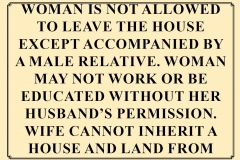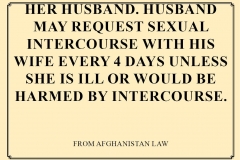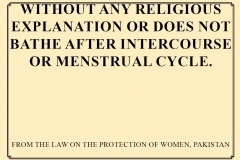Sweet home sadism
Sweet home sadism
S&M housewife
God’s word

’On the Road to Matrimony’, 16′ 42”, 2014
Sweet home sadism
The fact that the female gender, for thousands of years, in all parts of the world, has been belittled, oppressed and exploited in various ways, apart from the awareness of the position of women in society, has not significantly changed her situation over the centuries, until the moment when she “takes matters into her own hands” and at least shakes, if she fails to overthrow, the notion of male supremacy, as the universal law of culture.
Although, in their essence, both sexes have the characteristics of the other, i.e. at the same time, they are active and passive, aggressive and obedient, masculine and feminine, throughout history, women, by giving in, or being forced to give in to their power, have witnessed gaining responsibilities appropriate to their tasks. In contrast, men could indulge their aggressive, dominant, and active urges to free will; so much so that they violated the alliance agreement with a similar female gender. It is not surprising, therefore, that women one day decided to remind men of their common belonging to humanity. Overwhelmed by passivity, tired of their own obedience, locked in their status of inferiority, women realized that the suppression of many of their desires and ambitions could finally stop. This acquisition of consciousness among Western women marked the beginning of a new war that lasted for centuries, and the wounds it produced have not yet healed. Unfortunately, we still witness the cruelty and violence that women endure, from their spouses or partners, much more often than from unknown men, although that is not excluded. Sexual violence is not just a woman’s private (personal) matter. It has always served as a means of controlling women, thus maintaining a social order based on the imbalance of power between the sexes, privileges and domination of men. Sexual violence is a general name for numerous forms of sexual behavior that are characterized by happening without consent, ie it is extorted by the use of force and / or threats.
The woman was and remains an unsolvable riddle, a mystery that instills fear to many members of the “stronger” sex. The patriarchal model, although declaratively condemned and “anathematized” in the media, is in fact, directly or indirectly, the dominant framework within which the average family functions, especially in this area. Such a relationship is conditioned by a long tradition and norms that hinder women’s freedom under various pretexts.
The works of Jane Stojaković, which, whether it is about paintings, drawings, video works, photographs or installations, focused on the modern subject, identity and critique of society, inevitably treat the problem of the (female) body, beauty and sexuality. The project entitled “Sweet home sadism”, which includes a series of photographs ‘’S&M housewives’’, the experimental film ‘’On the Road to Matrimony’’ and the installation of ‘’God’s Word’’, points to the patriarchy still present and, in some parts of the world, legally supported as a system of sexual oppression. It is also a reflection of the political system, which, in our societies, has found its root in a certain theology. Depending on the extent to which that theology became more authoritative or tolerant, respecting or not the individual, patriarchy has shown, throughout history, different faces, ranging from the worst to the most tolerable. Men who initially advocated the overthrow of such a political system would stop in front of the threshold of sex, because, although most of them tried to get rid of the political patriarchy, wanted to keep the family one at all costs.
The heroine of the photographs is a young woman, seductive-looking, who, in the costume of a French maid, does housework. A closer look reveals traces of blows, bruises, hematoma and other signs of visible violence, unsuccessfully covered with layers of make-up. It is a matter of systematic and long-lasting violence, which, in the end, she decides to stop, in the only possible way – by killing the perpetrator.
The experimental film, ‘’On the Road to Matrimony’’, in a witty and parodic way, shows a model of a traditional, desirable way of behaving, looks, in general, of all the actions that accompany the choice and proposal of the future bride. Within the Orthodox patriarchal model, the church plays an extremely important role, so the young couple goes to the priest for advice, after which, in their heads, they create a rather disturbing picture of the future life, and decide to assemble the community in a balloon, neither in heaven nor on earth, where neither God’s nor custom laws rule.
Milica Stojaković
God’s word
A brief overview of female repression
Many scholars claim that matriarchy once ruled, but throughout known history, women have been and still are subordinate to men. Until the first feminist movements in the 20th century, a woman was disenfranchised, treated as a slave, without the ability to be educated and manage her own life, forever in the possession of a man (father, brother or husband). Even with the first civilizations, women are assigned the role of the Other, subordinate, but with the emergence of Christianity and Islam, misogyny takes on incredible proportions. The Bible and the Qur’an, as holy books, God’s laws, speak of a woman, not only as a being less valuable than a man, but also corrupt in core and evil. Such a view of the world laid the foundation for centuries of torture of women.
In ancient Greece, the cradle of European civilization, women did not have the right to education, they could not participate in political life or dispose of property, more precisely, they were the property of their fathers and husbands. According to the law, the abused wife’s husband had to divorce or lose his citizenship. She was deprived of the right to wear jewelry and participate in public ceremonies. Under Solon’s laws, an unfaithful wife could be sold into slavery.
In the time of ancient Rome, a man had absolute power over a woman, he could torture her, even kill her. Unlike a woman, a husband was never guilty if he had intercourse with another woman, unless it was someone else’s wife because he would insult another man. Unlike many other traditions, in Rome, defloration was left to slaves.
In contrast, losing virginity before marriage was a terrible sin for the Circassians from the Caucasus. In that case, they could refuse the marriage, and the parents sold or killed the daughter.
The Assyrians and Babylonians cut off their ears for female infidelity (which also included courtship).
The Egyptians cut off their noses for the same thing.
Inde people would let such a woman to be torn to pieces by dogs, and her lover burned alive on a hot, iron plate.
The Jews would stone them both.
The Germans, for those women, had punishment by suffocation in the swamp mud.
The Turks put them in sacks with stones and threw them into the water.
In Albania, they cut off noses and skinned them off alive.
In Montenegro, their nose was cut off or the husband would put bread on the woman’s head and hit it with an ax.
Muslims in Bosnia and Herzegovina skinned or cut them to pieces. They also cut off their noses and ears or would drive them away with haircuts, without ears and noses.
According to the Qur’an, an infidel could be locked in a house and left to die of starvation.
In France, they were also imprisoned, but in a fortress or monastery, or they would be publicly flogged to death.
The Serbs tied them to horses tails and tore them apart, or they would smear them with powder and tar and burn them. During the reign of king Dusan, their hands and noses were cut off, and during the reign of Karadjordje and Milos, a woman would receive 25-30 whips. In medieval Serbia, there was a law that if a woman was abducted and her husband returns her, he had to blind her with his own sword in order to mark her for life.
In the Fiji tribe, a wife would be bought, and in case of infidelity, the husband could eat her.
In the period from the 7th to the 18th century, in Europe, thousands of women were accused of witchcraft and were most often burned at the stake. What is behind the mass persecution of witches throughout medieval Europe is the fear that women, gaining knowledge and freedom, would gain power. Women who did not accept the order, especially those who were in some way eccentric, refusing to take on the role of housewives, or women who were independent of men, whether widowed or unmarried, as well as those who aspired to science, represented the threat to the established order, undermining the man’s position of power. Such women were also ascribed moral weakness, debauchery, for which they were expelled from society and punished under the accusation of collaborating with the Devil himself.
Thus, even the period of Renaissance humanism was not a boom for the female gender. In the 15th and 16th centuries, women also lost the little economic power they had. Men leave home to work while a woman remains trapped inside the walls of the home, left to do housework and take care of children, without the opportunity to receive even the most basic education. It was not uncommon even for aristocrats to be illiterate, because there was no place for a woman in science, art or philosophy.
Marriages were arranged in advance until the 20th century (in many countries it is still part of the tradition). Seven year old girls were married to adult men, although the marriage came into force only at the age of 12. In Serbia, often happened that a mature and strong girl, who could do housework, get married to a young boy. Until he grew up, his father performed his husband’s duty.
In the 12th and 13th centuries, husbands used “belts of innocence”, made of metal, to protect themselves from their wife’s infidelity. The last belt of this kind was made in France in 1910.
In the 14th century, the court refused to accuse the rapist if the victim became pregnant because it was considered God’s sign of marriage.
In 1996, the last Catholic monastery in Ireland, where families brought abused women, was closed. The children, who arose from such relations, were taken away from their mothers, while they remained imprisoned in the monastery for the rest of their lives, left at the mercy of the nuns, to serve their sentences. The man never bore the consequences because the woman was found guilty; she was the one who seduced man and led him to sin.
Today, in the 21st century, after the third wave of feminism, from the beginning of the 90s, when the words feminism, gender, political correctness are widely used in the West, for most countries it is just a distant echo. Even Western culture cannot boast that it has succeeded in achieving gender equality. Women are abused and discriminated on a daily basis, at home or at work, while certain spheres of activity remain reserved only for men. “I am angry with male hypocrites – and I mean almost all men – who are trying to spread the idea that women today are completely free and independent because they can get a job, attend schools and colleges. The goal of these hypocrites is to evoke in women a sense of gratitude for this small step forward and stop them from striving for the better. But the real struggle is just beginning. “(Buseina Shaaban, „I desnom i levom- Životne ispovesti arapskih žena“, Belgrade 2001).
Bibliography:
Helena Wojtczak 2009.
http://www.historyofwomen.org/oppression.html
Svetozar Cele Dunđerski „Preljuba i kazna“, 2013.
http://www.akuzativ.com/teme/289-preljuba-i-kazna
Buseina Šaaban, „I desnom i levom- Životne ispovesti arapskih žena“, Beograd 2001.














